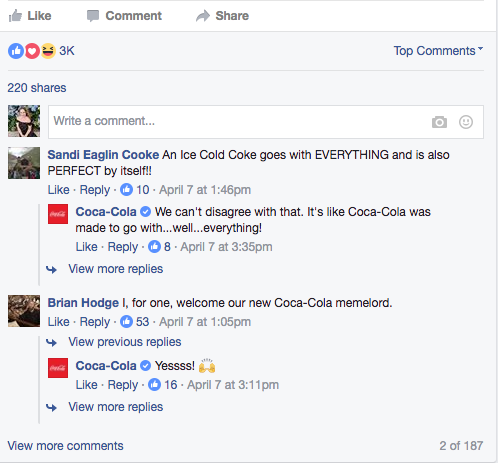 In today’s digital world, interacting with friends on Facebook or followers on Twitter, is a main part of society. Facebook in particular allows users to easily connect with their long-lost friends, or just close family members. Being connected for most people is a priority, whether it is updating your Facebook status, or messaging a coworker about tomorrow’s meeting. Connectivity also ties in with marketing. When users share branded content on Facebook, they are not only connecting other people with that content, but they are also making a connection between themselves and the brand.
In today’s digital world, interacting with friends on Facebook or followers on Twitter, is a main part of society. Facebook in particular allows users to easily connect with their long-lost friends, or just close family members. Being connected for most people is a priority, whether it is updating your Facebook status, or messaging a coworker about tomorrow’s meeting. Connectivity also ties in with marketing. When users share branded content on Facebook, they are not only connecting other people with that content, but they are also making a connection between themselves and the brand.
Back in the days when the only method of advertising was buying space in a magazine, or time on the radio, there was not a whole lot of interactivity occurring between the audience and the brand. With the emergence of the Internet and social media, the game of advertising changed. On Facebook, when a user shares an emotional advertisement with his or her friends, the receivers of that ad will feel more compelled to consider whatever product it may be, and take action and purchase it. Social media has allowed the audience to become the advertisers. Users feel more comfortable buying something that was recommended to them through a friend on Facebook.
Take a look at a campaign that Maserati performed on Facebook. Their goal was to engender consumer interest in their new Levante SUV. To achieve this, they created video ads that they posted on Facebook and Instagram. The videos all had a unique selling proposition, such as the driving experience or the exterior features.  Using Facebook advertising tools like Lookalike Audiences and Custom Audiences, Maserati was able to target the right audience for them. As a result of this campaign, Maserati reached more than 4 million on Facebook and Instagram, and produce 21,000 leads. Of those 21,000 leads, 127 Levantes were sold, making Maserati’s campaign a success. What really pushed their campaign to glory was the disseminating of the videos by users on Facebook.
Using Facebook advertising tools like Lookalike Audiences and Custom Audiences, Maserati was able to target the right audience for them. As a result of this campaign, Maserati reached more than 4 million on Facebook and Instagram, and produce 21,000 leads. Of those 21,000 leads, 127 Levantes were sold, making Maserati’s campaign a success. What really pushed their campaign to glory was the disseminating of the videos by users on Facebook.
Sharing branded content on Facebook is the best way for companies to become connected with their audience, and for their audience to become connected with each other. Facebook Messenger allows companies to connect with their audience on a much more personal level than sharing. And in this wave of messaging that today’s society is in, it is imperative for brands to take advantage of the opportunities like this one on Facebook. Connectivity on Facebook allows brands to easily and affordably reach their audience, and provide them with the right amount of information for their product. Using Facebook’s many tools for advertising, accomplishing these connections with audiences is easier than ever. Connecting with audiences, and connecting audiences with each other is a golden opportunity for brands to establish a trust with them, and for their business to grow and prosper.

 Connectivity is the glue of advertising; it joins consumers and advertisers together and creates a strong bond. In order to be truly successful in utilizing Facebook ads, you need to connect. It is important to appeal to consumers in order to create loyalty for your brand. The idea of connectivity is shown in two distinct types: connection of consumers with a brand and connection of consumers with consumers. Both of these have great impacts on the customer when it comes to
Connectivity is the glue of advertising; it joins consumers and advertisers together and creates a strong bond. In order to be truly successful in utilizing Facebook ads, you need to connect. It is important to appeal to consumers in order to create loyalty for your brand. The idea of connectivity is shown in two distinct types: connection of consumers with a brand and connection of consumers with consumers. Both of these have great impacts on the customer when it comes to  Advertising has had to adapt to the dramatic change created by new media—prominently social media. Customers today are smarter than ever and they are able to recognize advertisements and sponsored videos/events. When consumers recognize blatant advertising they are prone to blocking it out. Therefore, brands need to come up with more entertaining and creative means of advertising. Brands recognize that their customers spend a lot of time on social media, therefore the best way to connect is to join the creative channel. Brands try to
Advertising has had to adapt to the dramatic change created by new media—prominently social media. Customers today are smarter than ever and they are able to recognize advertisements and sponsored videos/events. When consumers recognize blatant advertising they are prone to blocking it out. Therefore, brands need to come up with more entertaining and creative means of advertising. Brands recognize that their customers spend a lot of time on social media, therefore the best way to connect is to join the creative channel. Brands try to 
